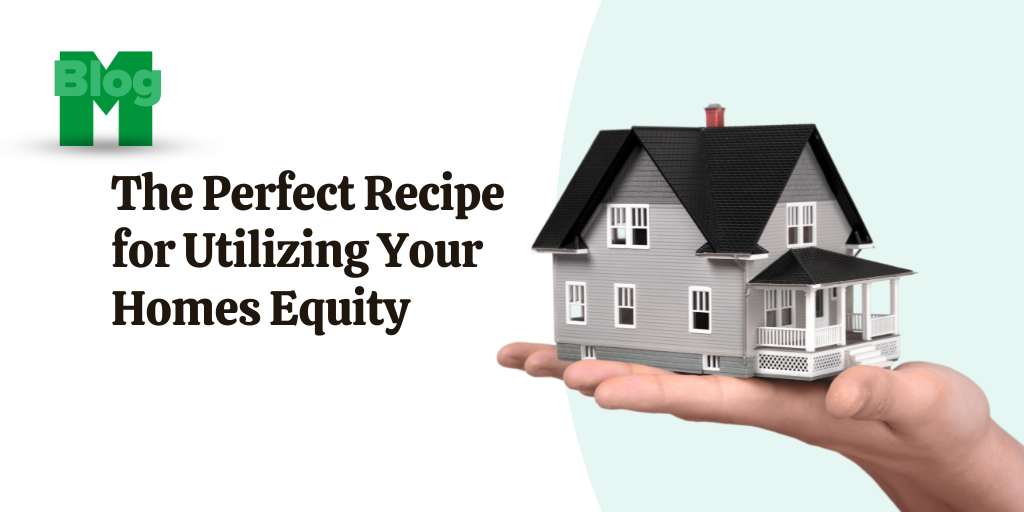
The Perfect Recipe for Utilizing Your Home’s Equity
Building home equity is one of the most favorable aspects of homeownership. Whether you sell it and earn the profits or borrow against it to reach other financial goals, home equity has many benefits.
Fortunately, many ways exist to build and use your home’s equity. There isn’t a right or wrong way to do it. Each homeowner has different ideas and capabilities. You should do what’s most comfortable for you, giving you the best outcome for your home equity.
So, what’s the perfect recipe for utilizing your home’s equity?
We’ve created three great options for you below!
3 Recipes for Utilizing Your Home’s Equity
There are three main ways to gain home equity, so I’ve created three recipes for you below to help you achieve your desired goals. Follow the recipe that helps you achieve your goals and see how beneficial it can be to be a homeowner!
The Home Improvement Recipe
You are in the driver’s seat for improving your home’s equity. The more you improve your property, the more profits you’ll earn. So here’s the perfect recipe for home improvements.
What You’ll Need:
- Blueprint for the desired improvements
- Supplies to complete the improvements
- Time to complete the improvements or hire professionals
- A new appraisal on the property
Steps
- Determine the desired improvements
You may already know what you want to improve on your property, but I suggest you look around the area and see what others have done. See how your property compares to others, not only in looks and features but also in value.
Choose the improvements that will provide the best return on your investment. Minor bathroom and kitchen remodels often have the best ROI, but see what’s most desired in your area.
- Set your budget
Home improvements can get out of hand fast if you don’t have a budget and a plan. Sit down with anyone involved in the process and discuss your budget. Handle your ‘needs’ in the home improvements first, and use any extra funds for ‘fun’ features or things you could do without but would love to have if possible.
For example, if you’re renovating an old bathroom, anything outdated should take priority in the budget. If there are extra funds, you can do something fun, like a unique bathtub or a heated floor.
Keep a buffer in your budget; usually, 10% – 15% is sufficient should there be any unexpected issues.
- Gather the necessary supplies
After creating a plan or blueprint for the desired improvements, you’ll need supplies to make them happen. If you’re a DIYer, head to the local hardware store and gather the necessary supplies. Don’t forget details like paint colors, flooring, or other decorative particulars.
- Start the repairs or hire a professional
When ready, it’s time to start the repairs/renovations. Be sure to work this into your budget, and don’t forget that time is money! If you aren’t experienced in renovations, it may make more sense to hire a professional to do it for you.
- Document your upgrades/renovations
Don’t forget to keep careful documentation of every upgrade you have done. Contracts and receipts are usually enough, but you can also take pictures along the way. You’ll need these for the appraisal when you are ready to refinance and/or sell the property and want credit for the upgrades.
- Enjoy the renovations
Once finished, enjoy your renovations! You put in the hard work and money, so it’s time to enjoy them.
- Decide how to use your home equity
Your final step is to enjoy the newfound home equity. A new appraisal will tell you how much your home is now worth, and then you can choose among the different flavors (listed below).
Tapping into Home Equity (Your Different Flavors)
- HELOC – This is a second mortgage on the property that borrows against the equity. Depending on your credit score, income, and affordability, you may be able to borrow up to 80% of the home’s total value minus any existing liens. A HELOC is a line of credit, so you get a credit line that you can withdraw, use, repay, and reuse as needed (like a credit card). Interest-only payments are required during the draw period (10 years), and after 10 years, you must repay any remaining balance with principal and interest (no more draws).
- Cash-out refinance: A cash-out refinance refinances your first mortgage but for a larger loan amount. You pay off your existing first mortgage, and any excess funds are distributed to you in a lump sum. You make principal and interest payments from the start.
- Traditional refinance: If you don’t need the cash-out but want more attractive terms on your mortgage, you can use your home equity to your advantage. You may secure a lower interest rate or be able to afford a shorter term to pay the loan off faster.
The Making Extra Payments Recipe
If you don’t want to make home improvements, another simple way to gain home equity is to make extra payments on your mortgage. This is a simple recipe that anyone can do by properly budgeting.
What You’ll Need
- Available funds
- A prepared budget
Steps
- Review your budget to determine how much you can pay
You have a minimum required mortgage payment, but if you review your budget and find extra available funds, you can put them toward your mortgage principal. Determine if you have extra money monthly, a few times a year, or annually.
- Make the extra payment
When you make the extra payment, be sure to note that it is to go toward the loan’s principal. Usually, your mortgage coupon will have a spot to state any extra payments you’re making and what they go toward.
- Calculate your new equity
As you pay down your balance, watch your home equity grow. Your mortgage dashboard should show the principal balance in real-time, so you can see how your equity grows with each extra payment.
Get a Shorter-Term Mortgage
If your budget allows, you can get a shorter-term mortgage by refinancing. The fewer years you borrow money, the more principal you cover with each payment. This automatically increases your home equity faster because you owe less on the home.
What You’ll Need:
- Available funds
- A plan on what you can afford
- A mortgage lender to refinance your mortgage
Steps
- Review your budget and decide what mortgage payment you can afford
You can refinance your mortgage into any term of 10 – 30 years, based on what you can afford. Remember, you must prove you can afford it with official income documentation. The lender will also evaluate your current debts to ensure you can comfortably afford all debts.
- Find the right mortgage
Check out your mortgage options, comparing the monthly payment and total interest costs over the life of the loan. Choose the option that’s most affordable but also helps you build equity faster.
- Refinance your mortgage
Complete a loan application, provide the necessary documentation, and go through the underwriting process, like you did when you bought the home. You don’t have to deal with sellers or sales contracts this time, so the process may go a little faster.
- Calculate your new equity
Your principal balance will decrease with each payment, leaving you with more equity. You will own your home lien-free much faster with a shorter-term loan.
How Will You Use Your Home Equity?
As you see, there are three great ways to utilize your home equity! Whether you have big goals, like buying an investment property or using the funds to pay for your child’s education, or just want the satisfaction of owning your home and increasing your net worth, you have many options.
Ultimately, you get the same result – a larger net worth, greater home equity, and the freedom to do what you want with the funds. Most people can borrow up to 80% of a home’s value, so if you intend to stay in the home, you can tap into the equity and put it to use in other ways.
The sky’s the limit, but it all starts with an investment in a home. How you manage that debt and make the most of your equity is up to you.



